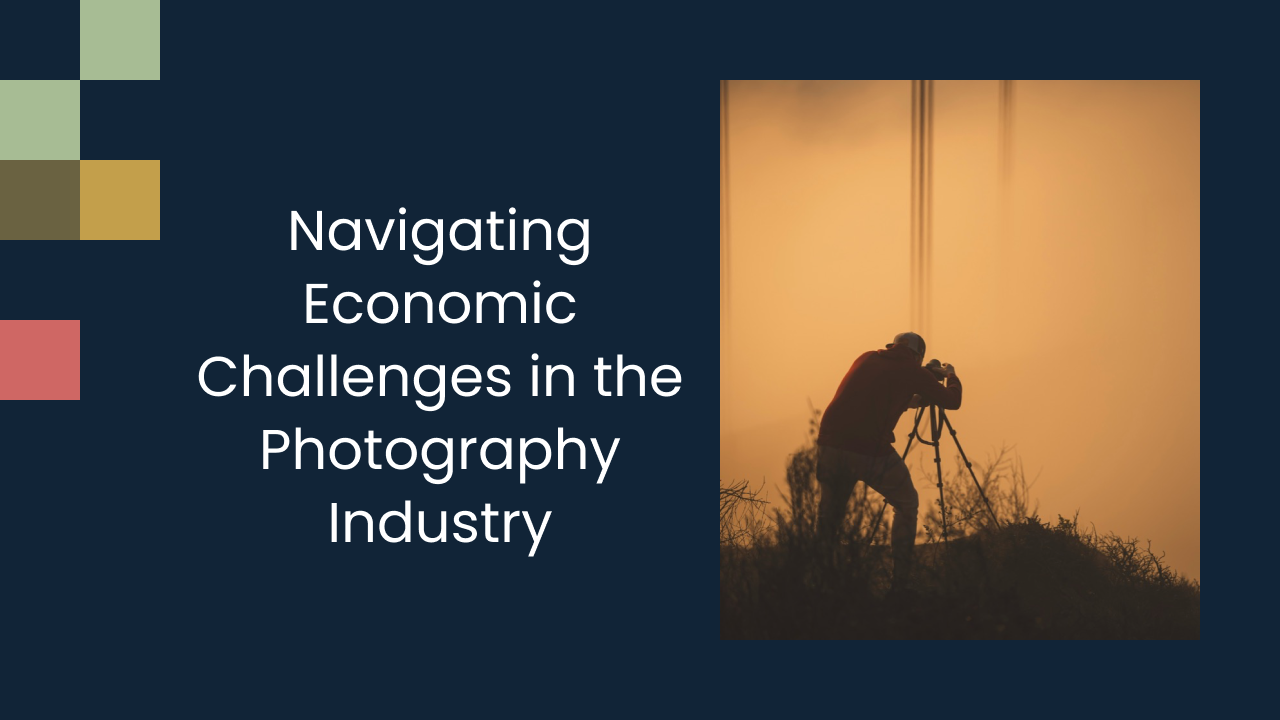Navigating Economic Challenges in the Photography Industry

The photography industry has always been subject to economic challenges, and in recent years, these challenges have been amplified by various factors. In order to stay afloat in an ever-changing market, photographers need to understand the current economic landscape and adapt their financial management strategies accordingly.
Understanding the Current Economic Landscape in Photography
The photography industry has undergone significant changes in recent years, largely due to the impact of digitalization. With the advent of smartphones and affordable digital cameras, the barriers to entry in the photography market have significantly decreased. This has led to a saturation of photographers and increased competition.
However, despite the increased competition, there are still ample opportunities for photographers to thrive in this evolving landscape. One area that has seen significant growth is the demand for professional photography services in the commercial sector. Businesses are increasingly recognizing the importance of high-quality visuals to attract and engage their target audience. From product photography for e-commerce websites to corporate headshots for professional profiles, photographers are finding lucrative opportunities in the commercial sector.
Moreover, the rise of social media has revolutionized the way people consume and engage with photography. Platforms like Instagram and Pinterest have become influential in shaping photography trends and have given rise to a new generation of social media influencers. Photographers now need to not only be skilled in their craft but also be adept at creating an online presence and marketing their work on various platforms.
Building a strong online presence is crucial for photographers looking to establish themselves in this competitive industry. They need to curate a visually appealing portfolio that showcases their unique style and expertise. Additionally, photographers must stay updated with the latest trends and techniques in photography to stay relevant and attract potential clients.
Furthermore, the advancements in technology have not only impacted the way photographs are taken but also how they are edited and post-processed. With the availability of powerful editing software and apps, photographers can enhance their images and create stunning visual effects. This has opened up new creative possibilities and allows photographers to push the boundaries of their art.
Another aspect of the current economic landscape in photography is the growing demand for stock photography. With the rise of online content creation, there is a constant need for high-quality images that can be licensed for commercial use. This presents an opportunity for photographers to generate passive income by submitting their work to stock photography websites.
In conclusion, the current economic landscape in photography is a mix of challenges and opportunities. While the industry has become more competitive due to digitalization and the saturation of photographers, there are still avenues for photographers to thrive. By adapting to the changing trends, building a strong online presence, and staying updated with the latest technology, photographers can position themselves for success in this evolving industry.
Financial Management for Photographers
One of the key aspects of navigating economic challenges in the photography industry is effective financial management. Budgeting and cost management are crucial for photographers to ensure that they can cover their expenses and generate a profit. This involves keeping track of expenses such as equipment costs, studio rentals, and marketing expenses.
When it comes to equipment costs, photographers need to carefully consider their options. Investing in high-quality cameras, lenses, and lighting equipment is essential for capturing stunning images. However, it's important to strike a balance between quality and cost. Researching different brands and models, comparing prices, and reading reviews can help photographers make informed decisions that align with their budget and photography style.
In addition to equipment costs, studio rentals can also be a significant expense for photographers. Renting a studio space provides a controlled environment for photoshoots, allowing photographers to have complete control over lighting, backgrounds, and props. However, studio rentals can quickly add up, especially for photographers who frequently work on location. To manage this expense, photographers can consider sharing studio spaces with other professionals or negotiating long-term rental agreements for discounted rates.
Marketing expenses are another crucial aspect of financial management for photographers. In today's digital age, having a strong online presence is essential for attracting clients and showcasing one's portfolio. This may involve investing in a professional website, search engine optimization (SEO) services, social media advertising, and online marketing campaigns. By allocating a portion of their budget to marketing, photographers can increase their visibility and reach a wider audience, ultimately leading to more bookings and revenue.
Furthermore, diversifying income streams is essential in reducing the reliance on a single source of revenue. Photographers can explore various avenues such as offering workshops, selling prints, or collaborating with brands for sponsored content. By diversifying their income, photographers can ensure a more stable financial foundation and mitigate the risks associated with economic fluctuations.
Offering workshops is a great way for photographers to share their knowledge and skills with others while generating additional income. Whether it's teaching basic photography techniques, advanced editing skills, or specialized genres like wedding or wildlife photography, workshops can attract both aspiring photographers and enthusiasts looking to improve their craft. By charging a fee for these workshops, photographers can not only earn extra income but also establish themselves as industry experts and build a network of like-minded individuals.
Selling prints is another avenue that photographers can explore to generate additional revenue. With the rise of online marketplaces and print-on-demand services, photographers can easily showcase and sell their work to a global audience. From landscape and nature prints to fine art and abstract photography, there is a market for various styles and subjects. By pricing their prints competitively and marketing them effectively, photographers can create a passive income stream that complements their client-based work.
Collaborating with brands for sponsored content is yet another way for photographers to diversify their income. Many companies are constantly seeking visually appealing content to promote their products or services. By partnering with brands that align with their photography style and values, photographers can not only earn a fee for their work but also gain exposure to a wider audience. Sponsored content can take the form of product photography, lifestyle shoots, or even travel photography, depending on the brand's needs and target audience.
In conclusion, effective financial management is crucial for photographers to navigate economic challenges in the industry. By carefully budgeting and managing expenses such as equipment costs, studio rentals, and marketing expenses, photographers can ensure that they can cover their expenses and generate a profit. Additionally, diversifying income streams through avenues like workshops, print sales, and sponsored content can provide photographers with a more stable financial foundation and reduce their reliance on a single source of revenue.
Adapting to Market Changes in the Photography Industry
Embracing technological innovations is vital for photographers looking to navigate economic challenges. The advancement of technology has led to improvements in camera equipment, post-processing software, and printing options. Photographers who stay abreast of these developments and invest in the right tools can gain a competitive edge and offer unique services to their clients.
One of the most significant technological advancements in the photography industry is the continuous improvement of camera equipment. From high-resolution sensors to faster autofocus systems, photographers now have access to tools that allow them to capture stunning images with incredible detail and precision. These advancements have not only enhanced the quality of photographs but have also opened up new creative possibilities for photographers. With the ability to shoot in low light conditions or capture fast-moving subjects, photographers can now push the boundaries of their artistry.
In addition to camera equipment, post-processing software has also evolved significantly. With powerful editing tools like Adobe Photoshop and Lightroom, photographers can now enhance their images, correct imperfections, and create unique visual effects. The availability of these software programs has not only made post-processing more accessible but has also given photographers the ability to express their artistic vision in new and exciting ways. From creating stunning black and white conversions to adding surreal elements to their images, photographers can now bring their creative ideas to life.
Furthermore, the photography industry has witnessed a revolution in printing options. With advancements in digital printing technology, photographers can now produce high-quality prints with exceptional color accuracy and longevity. From fine art prints to large-scale wall displays, photographers can offer their clients a wide range of printing options to showcase their work. This not only adds value to the photographer's services but also allows clients to enjoy their photographs in a tangible and long-lasting form.
Another significant shift in the photography industry is the rise of freelance photography. Traditional employment models have given way to a gig economy where photographers often work on a project basis. This offers both opportunities and challenges to photographers, as they must constantly seek new clients and adapt to the demands of different projects.
The freelance photography market provides photographers with the freedom to choose the projects they want to work on and the clients they want to collaborate with. This flexibility allows photographers to explore different genres of photography, experiment with their creativity, and build a diverse portfolio. Additionally, freelancing offers photographers the opportunity to work with a wide range of clients, from small businesses to multinational corporations, allowing them to gain valuable experience and exposure.
However, the gig economy also presents challenges for photographers. With increased competition and a constantly evolving market, photographers must continuously market themselves and their services to stand out from the crowd. Building a strong online presence through a well-designed website and active social media profiles is crucial for attracting potential clients and showcasing their work. Additionally, photographers must stay updated with the latest industry trends and adapt their skills to meet the changing demands of clients.
In conclusion, adapting to market changes in the photography industry is essential for photographers to thrive in today's competitive landscape. By embracing technological innovations, photographers can enhance their skills, offer unique services, and stay ahead of the curve. Furthermore, understanding the dynamics of the freelance photography market and actively seeking new opportunities can help photographers build a successful and fulfilling career in this ever-evolving industry.
Strategies for Overcoming Economic Challenges
Building a resilient photography business model is essential for photographers to overcome economic challenges. This involves understanding market trends and having a clear vision for the direction of the business. By diversifying their client base and streamlining their workflow, photographers can ensure that they are well-positioned to weather economic downturns.
Effective marketing and branding strategies are also crucial in attracting clients and differentiating oneself in a crowded market. Utilizing social media platforms, creating a compelling portfolio, and networking within the photography community can all contribute to building a strong brand reputation.
The Future of the Photography Industry
As we look towards the future, it is important for photographers to be aware of predicted economic trends in the industry. Keeping up with industry reports, attending workshops, and engaging in ongoing learning can help photographers anticipate and prepare for future challenges.
Photographers should also be prepared to adapt to changing client demands and industry developments. This may involve embracing new technologies, exploring niche markets, or staying ahead of emerging photography trends. By being proactive and open to change, photographers can position themselves as industry leaders and secure their place in an evolving market.
Preparing for Future Challenges in the Photography Industry
In conclusion, navigating economic challenges in the photography industry requires a combination of financial management, adaptability, and proactive strategies. By understanding the current economic landscape, embracing technological innovations, and fostering resilient business models, photographers can not only survive but thrive in a competitive market.
The future of the photography industry holds both opportunities and challenges. By staying informed, being prepared for change, and continually honing their skills, photographers can position themselves for long-term success in an ever-evolving industry.
Looking for an easier way to manage and grow your studio? Experience a platform built by a photographer, for photographers. Try it free for 2 weeks.












